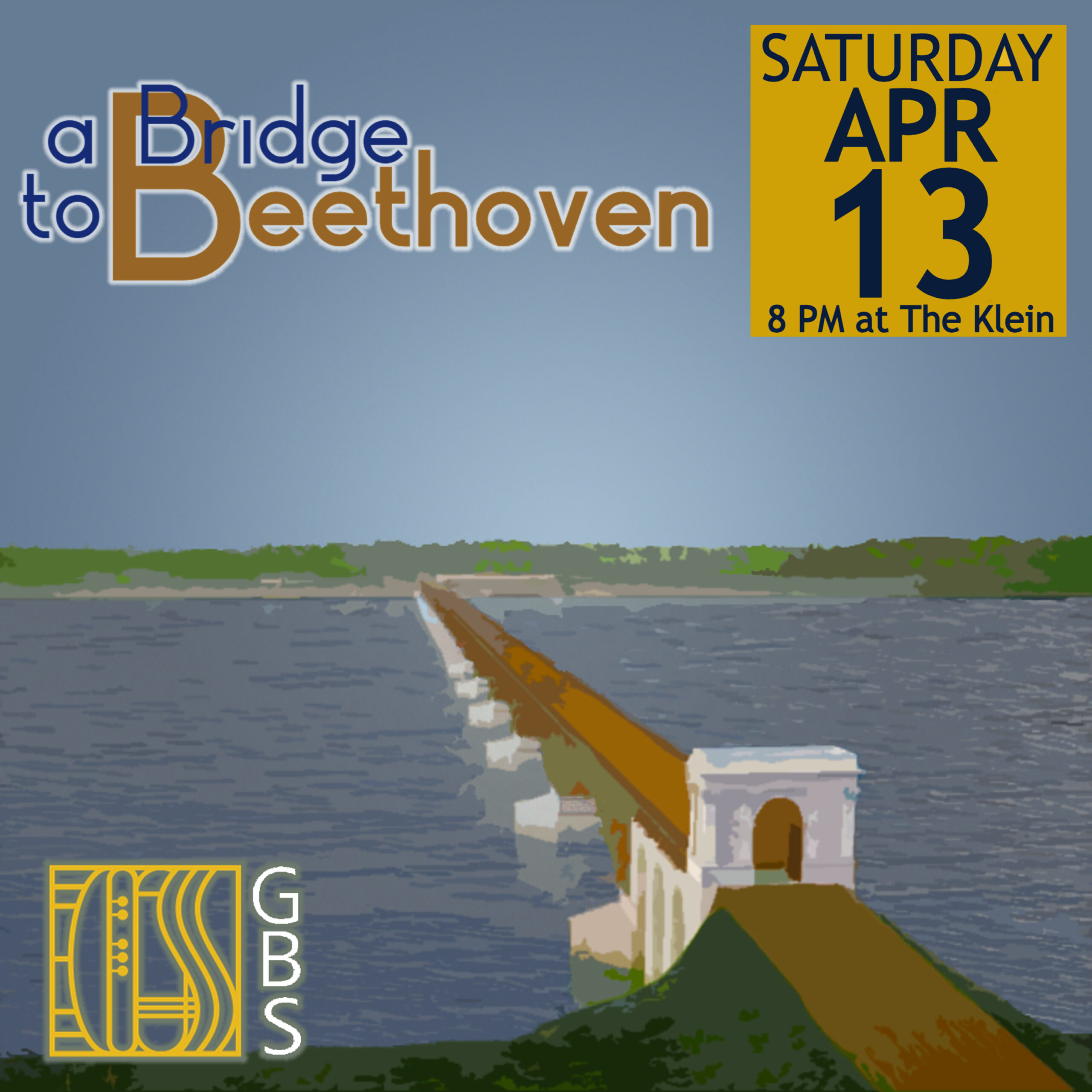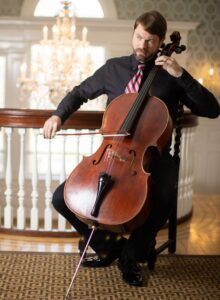
- This event has passed.
A Bridge to Beethoven


We close our 78th season with Beethoven’s joyful Symphony No. 8, and two great 20th-century Russian composers who revered Beethoven. Prokofiev’s Classical Symphony and Shostakovich’s Cello Concerto No. 1, featuring Dr. Nicholas Hardie soloist, GBS’ own Principal Cellist – pay homage to Beethoven, a century and a half later and a thousand miles east.
Program Notes
April 13, 2024
Alice M. Caldwell, Ph.D
Sergei Prokofiev, Symphony No. 1 in D major, Op. 25, “Classical”
In the context of music history, the twentieth century is sometimes described as “the century of -isms.” Of all the relevant movements, neoclassicism is perhaps one of the more accessible of those “-isms.” While some date the first example of neoclassicism from Stravinsky’s Octet for Winds of 1923, representations of eighteenth-century and older music had a tradition going back to Mozart, especially in music for the theater. Twentieth-century neoclassicism can be seen as a rejection of both the atonal modernism developing early in the century, and of the excesses of late Romanticism in the previous century.
Prokofiev’s “Classical” Symphony of 1917 harks back to the symphonies of Haydn, Mozart, and even the Mannheim school, opening with an energetic, upward D-major arpeggio that was practically a cliché of the eighteenth-century symphony. But harmony and rhythm tell a more modern story, and even the second theme, which duly follows the rules and appears in the dominant key, makes enormously wide leaps that keep us grounded in the twentieth century. Prokofiev proceeds from the opening sonata-form movement to a graceful slow movement, but then upends the traditional third movement minuet-trio by replacing it with a 4/4 gavotte where another wide-leaping melody is accompanied by modern harmonies. The lively fourth movement closes the work in the spirit of Haydn. It is interesting to note that Prokofiev himself bestowed the name of “Classical” symphony while declining to associate himself with any particular “-ism.”
Dmitri Shostakovitch, Cello Concerto No. 1
A work of intense energy, considered one of the most difficult in the repertoire, Shostakovitch wrote his first cello concerto in 1959 for his friend Mstislav Rostropovitch. Soloist Nicholas Hardie points out the deep influence of Rostropovich on Shostakovitch’s concept of the work, writing that it “reflects the power, emotion, and character Shostakovich saw in his playing. It is also the reason it is so fiercely difficult.” Scored for a chamber orchestra of strings, winds, horn, celesta and timpani, the four movements are further divided into two sections–the first, followed by the second/third/fourth continuously attached. Characteristics of neoclassicism link it to the other works in our program. The first movement opens with a strong, four-note theme, answered by a military-sounding motive, giving the feeling of a “jocular march,” as Shostakovich himself described it. The four-note motive will pervade the first movement, and return in the third and fourth, reminding us of Haydn and Beethoven’s use of intense motivic development.
The second movement takes the traditional form of a slow movement, with the cello playing a lyrical melody reminiscent of an Eastern European folk song. Following an intense buildup, the cello brings back its theme played in delicate harmonics, answered by the ethereal tones of the celesta. This leads directly to the third movement, entirely devoted to a solo cadenza. Here the soloist works some of the previous themes in passages of tremendous virtuosity, until the orchestra bursts out again into the last movement. We feel rhythms that are dance-like but diabolical, possibly an expression of the subversive humor with which Shostakovitch upheld his artistic integrity during the Soviet era. Embedded in the texture is a brief, concentrated, and distorted quotation from a Georgian folksong said to be a favorite of Stalin (dead for six years at the time of composition). The four-note motive of the opening returns with great emphasis to bring the work full circle to its conclusion.
Beethoven, Symphony No. 8 in F major
With the Eighth Symphony Beethoven’s turbulent middle, or “heroic” period, came to an end, and it foreshadowed the further musical boundary-pushing to come, following a difficult interval of life circumstances, in his late period. The year 1812 saw Beethoven’s personal relationships in disarray with respect both to his brother and to the unnamed “Immortal Beloved” addressed in a letter found after Beethoven’s death. Nevertheless, he completed both the Seventh and the Eighth symphonies in close succession. The Seventh Symphony premiered to great public approval, with its appealing rhythmic vitality and familiar forms including theme and variations, fugue, and minuet and trio. When asked why the more subtle Eighth did not generate quite as much enthusiasm, Beethoven replied, ““because it is so much better.”
Beethoven had already taken the conventional minuet and trio of the Classic era and turned it into the more humorous, spicy, and sometimes even diabolical scherzo (literally, “joke” in Italian). In the Eighth Symphony, the spirit of the scherzo pervades all four movements: there are rhythmic and metrical surprises, formal twists, and a novel use of the name. The first movement gives us unusual phrasing, syncopated accents, recurring octave leaps, and prominent hemiola (a temporary change of meter by shifting the accent). The movement ends with a wisp of the main theme. For the expected slow, second movement, Beethoven appropriates the name “Allegretto scherzando,” imposing the sound and feel of a scherzo on the slow movement. Some of the question-answer phrases recall the dialogue of comic opera. The constant ticking of repeated notes can be heard in various ways. Sudden dynamic changes and flurries of sixty-fourth notes add to the comic atmosphere. Then, since the scherzo slot has already been filled, Beethoven provides an old-fashioned minuet and trio for the third movement (at least, according to the title). But the scherzo spirit continues, with entrances in the “wrong” place to contradict the decorum implied by the name. For the finale, the musical jokes take the form of unexpected harmonies and keys, punctuated with sudden pauses, a return of the octave theme from the first movement, then an ending with one of the most emphatic statements of the tonic harmony in the repertoire.
Click here then click “Subscriptions” for subscriptions at deep discounts.